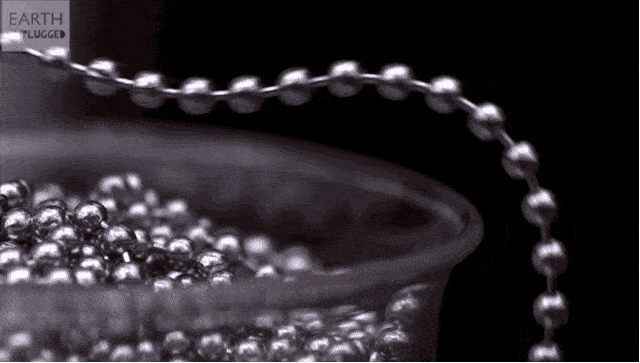It seems more like a magic trick than pure physics – the fountain-like motion of a chain of beads has puzzled millions around the world with its apparently gravity-defying behaviour. Now, physicists have found an explanation for it – but it’s far from intuitive.
British science presenter Steve Mould, who made the experiment famous with a video that went viral on the Internet, claimed that at the very basic level, this is a manifestation of nothing more than inertia: the falling chain has downward momentum, causing an upward momentum in beads leaving the pot. This effect makes them leap faster than gravity can slowly reverse their momentum. This explanation, while simple, elegant, and apparently correct… was wrong; physicist John Biggins of the University of Cambridge, UK has a different take on things.
He explains that if inertia were in fact the cause, then the chain would be stationary at the top of the curve – in the same way a ball or a coin is stationary at its highest point:
“If that were true, it would mean the chain would pile up in the top region, which we don’t see,” he adds.
Things, he believes, are way more complicated than that; the only explanation for the rise of the chain is a kick from the pot from which it is being pulled. In order to understand how this works, we have to rethink what a chain really is.
Rather than a flexible string of isolated beads, the chain is more like a series of short, rigid ‘rods’, say the authors, who actually published a paper today in Proceedings of the Royal Society A. In their model, each rod is made up of three beads and two connectors. The size of a rod corresponds to the number of beads it takes to turn a section of chain back on itself by 180 degrees (it takes six). When a rod is pulled up, two things happen. It lifts, but at the same time, it also starts to rotate.
“The far end of the rod under those two motions actually goes down, and therefore pushes down. And that gives rise to this extra kick from the pot which drives the fountain.”
Without this extra kick, it would still eventually flow down, but it wouldn’t create the ‘fountain’ we see here. The paper itself is very interesting for several reasons – and it is still up for debate.
“This is a neat paper,” says James Hanna, a mechanician at Virginia Tech, who has tackled similar problems in horizontal chains. He says the explanation is plausible, but may not be the whole story. Although Biggins and Ward suggest that other, sideways forces — caused by the configuration of the chain in the pot — might also be at play, ultimately they predict that a chain falling from a given distance produces a steady-height fountain, he says. Real world videos show the chain’s behaviour is far from steady, he adds. “I’m not 100% convinced there is a steady state. I would love to see a really long experiment, with a mile long chain. But that’s not really feasible I suppose,” he adds.
Via Nature.







